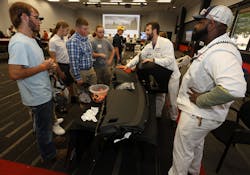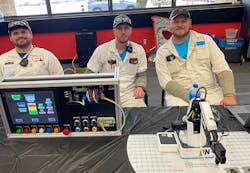Honda Tunes Up Its Manufacturing Day: Tour, Talk, Touch, Ask Questions, Get Good Swag
September 29, 2023, wasn’t the first Manufacturing Day put on at Honda Motor Co.’s Marysville, Ohio, campus, but it might have been the best Manufacturing Day. Three straight years of pandemic Zoom-only gatherings will do that. There was time to recharge and refresh, look at things anew and tap into enthusiasm for hosting middle, high school and vocational tech students at the annual career outreach day. (The national Manufacturing Institute encourage and promotes the event in hundreds of locations throughout the U.S.)
During planning, Stacey Owen, a Honda engineer who is engagement and morale lead for Marysville’s welding department sent out an informational email about Manufacturing Day to her fellow welders, “and within 12 hours, I had support from the full team.”
That support included helping staff the Manufacturing Day event, alongside stamping engineers, quality people, mold designers and more. The mood was upbeat yet down-to-earth. Volunteers encouraged kids to try out a mini robot welder, tinker with a human-machine interface and put on worker gloves and touch the imperfections in a “bad” bumper. They also answered questions, lots of questions. “What kind of plastic is this? How much is the plastic? How much does a bumper cost?” And, particularly astutely, “What spec of material do you use for that part?”
“I was kind of surprised how some of [the students] actually seemed to care about what they’re learning here today,” said April Tatman, a stamping department associate in a white lab coat. “They have asked about my job. A couple kids asked what I majored in. And they were trying to decide what they wanted to do. And I was like, ‘This is what I did.’ Because it’s very general, mechanical engineering. You can do almost anything with it.”
This is the biggest year yet for Manufacturing Day school tours at Honda and, not coincidentally, the first year Marysville’s Manufacturing Day took place on-site at the plant, rather than across the street at the training center. The day included a full tour of the workhorse plant where engineers huddled, parts delivery workers strode and rode by and a behemoth blue robot nickname G-Smurf installed engines and front suspensions into car bodies, shooting bolts through.
Plant tour guide Eric Wietzel, a member of the safety team, explained how different jobs fit into overall Honda operations and that people take many different paths to work at Honda. In the parts area, he defined supply chain management and explained that it is large part of Honda. It's also a career path students could pursue, with advancement opportunities. “Our supply chain manager now is an electrical engineer,” he said.
More questions from the teens and preteens in the group. “How often do robots make a mistake?” “Has anyone ever crashed a car here?” (Yes.) “How long does it take for a car to be made?” “Where does a defect go?” And more talk from Wietzel about career pathways: Parts designer, engineering contractor, artist who designs the interior of the car. “Don’t pigeonhole yourself, that engineering looks like this or that," he said.Meredith Reffey, an engineer who is now Honda America’s department lead for workforce partnership, said that connection between areas of study and careers was intentional.
“It’s honestly something we’ve tried to do across the board, is to show the students, ‘Look at how many careers there are inside of Honda, and in manufacturing in general,’” she said. “To say, ‘You know, you could do supply chain management, you could be an engineer.' Being an engineer could mean 500 different things in any one of our facilities."
In the past, new Honda engineers flowed in from the well-respected engineering program at nearby Ohio State University, among other colleges. But competition is intensifying for those graduates, with advanced manufacturing booming and new companies tapping into the workforce around Marysville, a still semi-rural area about 35 miles outside of Columbus. “We used to be the only game in town,” said plant General Manager Jun Jayaraman. “Now there’s so many companies around here. And then Intel is coming to the other side of Columbus.”
And the Honda plant is about to get more high-tech. Soon, battery and electric vehicle assembly will be arriving. A small, bare rectangle of space in the plant (where otherwise no inch is spared) shows where new robots will go, one of the first clues of the change.
“There’s going to be a lot of high-tech equipment that’s going to be installed in this new area,” said Jayaraman. “And that’s obviously one of the reasons we want to get people involved and understanding what manufacturing is."
The toughest job to fill at Marysville, like at many plants around the U.S., is maintenance associate. There is a pathway for that, too. Reffey says that equipment service technicians can get hired right out of high school, “going into production and then working their way into the [maintenance] technician role.” They may already have some applicable technical education.
“A lot of our high schools are teaching robotics,” she said. “The students know how to program a robot, which gives them a huge leg up on some of our engineers who go through a four-year program, but never touch the Teach pendant (training module for programming the robot). So they have the lab, and they have the advantage.”
A confluence of events made this year’s Manufacturing Day the most involved yet, said Reffey. (Even the swag bags were a notch above the usual, packed with Hydro-Flask-ready stickers, robot-welded keychains and enough candy to fill a Halloween basket.)
COVID, of course, made a labor shortage across manufacturing more dire. People of all ages left the workforce in higher numbers and older, more experienced workers retired early. Honda needed to develop more people, its eye also on talent competition from neighboring plants.
At the same time, with the student loan crisis, students and their families are more receptive to alternatives to four-year degrees. Honda ramped up its partnerships with high schools and tech schools “to make sure that the whole synergy happens,” said Reffey. This year, 1,600 students from 40 schools are visiting Honda plants. “It’s growing. I would say, post-COVID, all of those pieces have really come together and the lightbulbs have gone on.”
Marysville Manufacturing Day visitors included students in engineering courses from three high schools in Dublin, Ohio, a suburb near Columbus whose population has increased from 30,000 to 50,000 since 2000. Lori Mesi, coordinator of Secondary Pathways and Partnerships for the Dublin City School District, said that the purpose of these visits are for students to better understand “how engineering relates into manufacturing in many, many different aspects. A lot of times, there’s a really narrow frame to what engineering can be, and they don’t automatically transfer that to manufacturing.”
Mesi said her role has shifted in recent years from career education to career pathways, making sure students see the connection between coursework and real-life vocations and have a plan mapped out. “One of the great things about these types of event is [students] get to hear from the associates on their career mobility,” Mesi said. “They say, ‘Oh, I started in production. Now I’m training others on robots.' For students to be able to hear that from someone that’s actually done it, it’s really meaningful.”
The plant visit is just one link in the talent chain. Part of Reffey’s work is to make sure Honda doesn’t lose touch with students once their interest is piqued. After the plant tour, engineering students are invited to visit Ohio State’s robotics labs. And Honda’s robotics associates pay visits to Dublin schools to talk about their work and do hands-on activities. “We try to keep it so it wasn’t just one touch point where we met with them and then said, ‘OK, good luck,'" says Reffey. "'Hopefully you make it here.’ We want to make sure that it is a regular engagement.”
Having engineers like Reffey in workforce development roles is also helping Honda attract more young women into traditionally male roles. The first time Honda’s robotics engineers visited Dublin, they stopped in at an engineering class and a physics class. The engineering classroom had “I think 10 boys, maybe one girl,” said Reffey. “Then we went to the physics classroom, and it was 10 girls, one boy. ‘Oh wait. How do we make the girls understand that the theory they’re learning in the classroom—here’s the application.' We want them to see that physics is a big part of engineering.’”
There is still one significant demographic that Honda hasn’t cracked yet: parents. “We’re breaking the stereotype around manufacturing with the students,” Reffey said. "But if we don’t also break it with the parents, we’ll only get so far. We were just talking about ways to bring the parts here and talk to them and do kind of a mini-Manufacturing Day for adults and have them see. That, I think, is our last hurdle.”
About the Author

Laura Putre
Senior Editor, IndustryWeek
As senior editor, Laura Putre works with IndustryWeek's editorial contributors and reports on leadership and the automotive industry as they relate to manufacturing. She joined IndustryWeek in 2015 as a staff writer covering workforce issues.
Prior to IndustryWeek, Laura reported on the healthcare industry and covered local news. She was the editor of the Chicago Journal and a staff writer for Cleveland Scene. Her national bylines include The Guardian, Slate, Pacific-Standard and The Root.
Laura was a National Press Foundation fellow in 2022.
Got a story idea? Reach out to Laura at [email protected]







